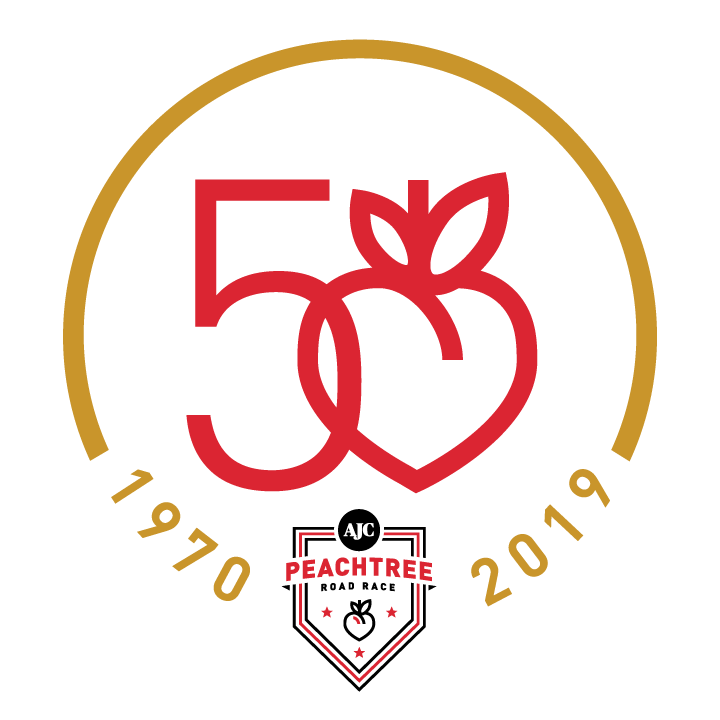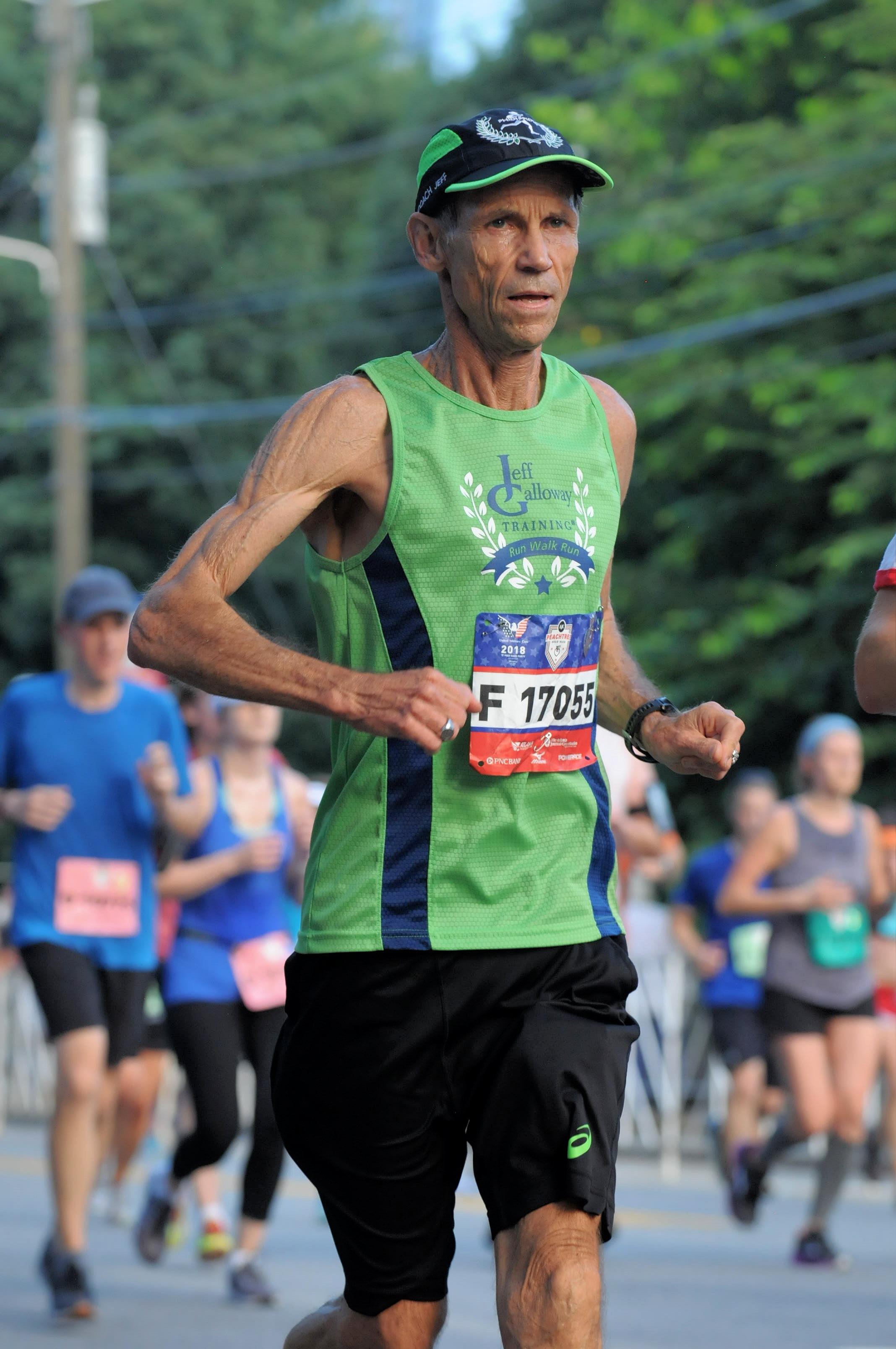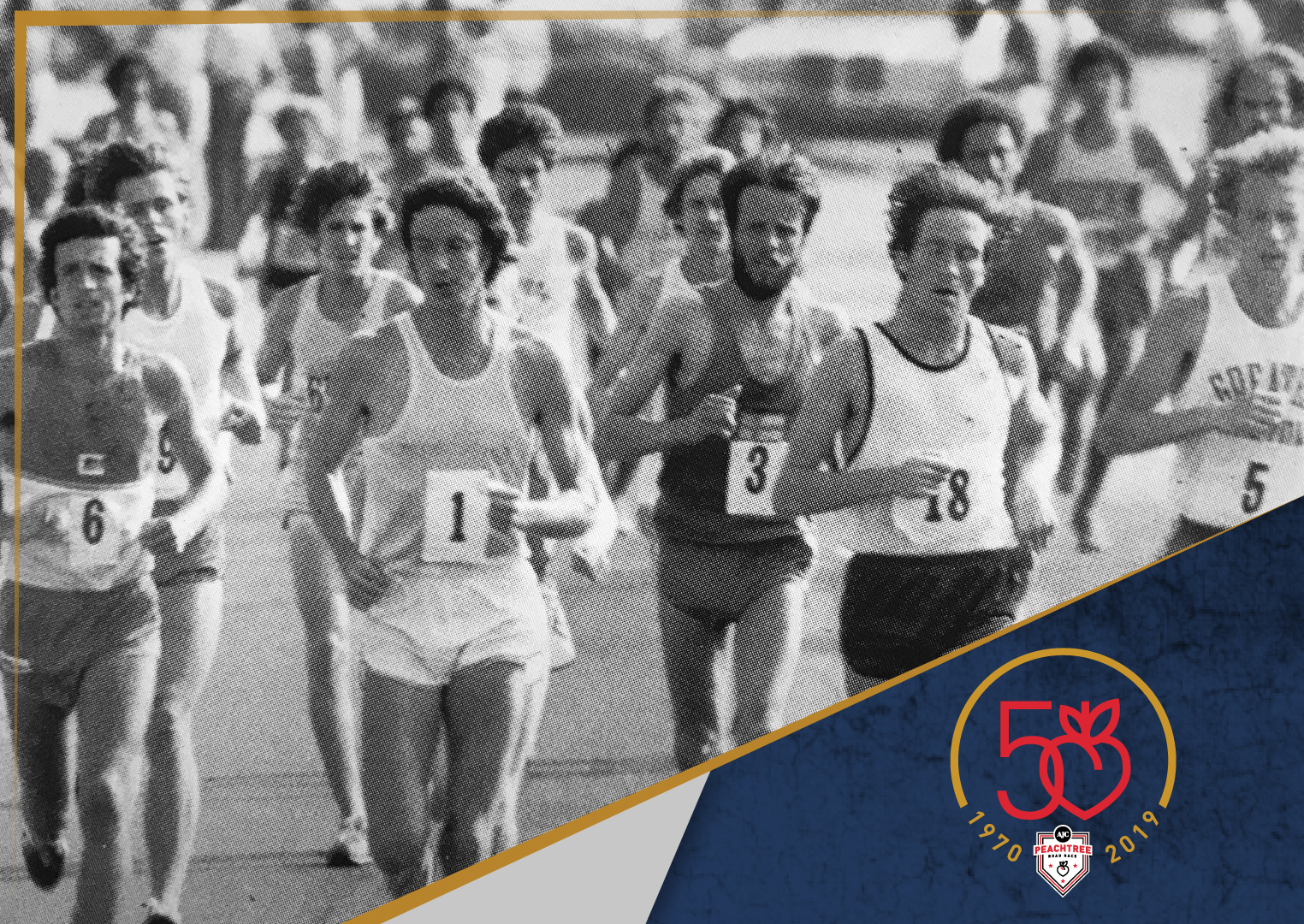Galloway's Methods at the Peachtree

Jeff Galloway’s father raised him to have a strong sense of responsibility and civic duty. That’s why Galloway arrived early for the first Peachtree Road Race in 1970. He figured that race director Tim Singleton could use some help. Galloway pulled into the Sears parking lot off Peachtree Street about 90 minutes before the 10 a.m. start.
But Singleton had everything under control. He had a VW bus, a folding table and a wife. What more could a race director ask for? He told Galloway to relax and focus on his pre-race preparations.
Galloway sought out Joel Majors, who he had been coaching at Georgia Tech. “We didn’t need much of a warmup, as it was plenty hot already, probably in the 80s,” Galloway recalls. “But we jogged a little and conspired about how we would run the race.”
The plan – to stick together for several miles – didn’t last long. Strong and fit from months of 70-mile training weeks after a stint in the Navy, Galloway cruised almost effortlessly to the front. At the mile, he had a modest lead. The rest of the way, he ran alone, reaching the finish in 32:21.6, with Majors 50 seconds back. But it wasn’t as easy as it looked.
“The old course was tougher than today’s, and there was no shade, no breeze, no water stops, no sprinklers and no mile times,” Galloway said. “I struggled up the last hill. All I could think about was finding a way to cool off. Fortunately, there was a fountain at the Equitable building. I went right in, and had a great soak.”
Fifteen minutes earlier, midrace, he had enjoyed a moment of reflection on Peachtree’s uniqueness and potential. Distance running had begun with cross-country races in remote parklands, and evolved to include occasional road races on narrow country roads like those on the mostly rural Boston Marathon course. Peachtree was the exact opposite.
“I had to pinch myself to believe I was running a 10K on an important street in downtown Atlanta,” Galloway said. “At one point, I actually thought, ‘You know, the visibility of an event that runs down a major city street could give road running a big boost.’”
You think? The 1976 New York City Marathon, the first to tour the city’s five boroughs, is often credited with launching the worldwide urban road-race boom. Peachtree came six years earlier.
Peachtree wasn’t Galloway’s first significant victory in Atlanta. He was just 18 in December 1963, when he won the inaugural Atlanta Marathon, on a tough 10-lap route around Chastain Park. After six laps, he was ready to quit. That’s when he learned that the runner far ahead of him had already walked off the course, making him the race leader. So he trudged onward, finishing in 2:57:21.
Not bad for a chubby, nonathletic kid who had only begun running four years earlier. His high school required sports participation, and Galloway selected cross country because he knew he was unskilled at other sports. He also noted that some of the runners were great storytellers. “I wanted to hang with them mainly to hear all the latest gossip,” he quips. “Soon I realized that running made me feel better because it switched on so many positive brain circuits.”
Two years after winning the 1970 Peachtree, Galloway made the U.S. Olympic team for the 1972 Munich Olympic Games, remembered for Frank Shorter’s commanding win in the marathon. Galloway should have been running that race, but wasn’t. It’s a long, complicated story that ends with Galloway “giving” the spot in his preferred event to teammate Jack Bacheler, and instead running the 10,000 meters.
In 1973, Galloway opened his first Phidippides running store in Atlanta. From 1975 through 1977, he served as a co-director of Peachtree. His job: to entice elite runners who would burnish the event’s reputation. He succeeded: in 1977, he lured Frank Shorter, Bill Rodgers, Don Kardong and four-time Olympic gold medalist Lasse Viren.
Kardong had already won the 1976 Peachtree en route to the Montreal Olympics, where he finished fourth in the marathon. “I was blown away by Peachtree,” he remembers today. “To run down the main road in town was a stroke of genius. When I got back to Spokane [his hometown], I told the local newspaper that we should have something similar, which gave birth to our Lilac Bloomsday Run [with over 35,000 runners annually]. I owe Jeff a big ‘thanks’ for inviting me in 1976.”
Bill Rodgers finished second to Kardong in 1976 and second to Shorter in 1977.. He was also impressed, in part by the local cuisine. “Don and I were astounded at how big the race was – 2,000 runners!” Rodgers said. “Jeff helped build it into a major part of the Atlanta scene. He also invited me to his home, and introduced me to grits. That was really cool.”
Sometime in the mid-1970s, Galloway had the “aha!” moment that helped change the culture and practice of running. Troubled by recurring injuries, he realized he could stay healthy and pain-free if he took walking breaks during his runs. Since then, he has promoted the Walk-Run-Walk method to beginning and mid-pack runners (and a few fast ones) through 31 books, 53 worldwide Galloway Training Groups and a series of weekend clinics and camps.
His philosophy and programs have inspired hundreds of thousands of often overweight, couch-ridden individuals to get up, get moving and achieve the seemingly impossible– including half-marathon and marathon races. He views his contribution as a gift received, not one given.
“For several decades I’ve been fortunate enough to get about 100 emails a day,” he said. “I respond and then get feedback that allows me to update and improve my methods. We are all a community of runners who support and enrich each other, and I consider myself so lucky that I can be a part of this every single day.”
His father became one of his most ardent followers. At 50, Elliott Galloway took stock of the extra 65 pounds he was carrying and decided to start running. He lasted the distance between two telephone poles, then had to quit. But he returned a day or two later, following his son’s prescription of slow, gradual adaptation. It worked. Elliott lost the weight and ran 50 marathons, including the centennial Boston Marathon of 1996 with Jeff at his side every step of the way.
Elliott also ran 34 consecutive Peachtrees before dropping out of the race on July 4, 2008, at age 87. He went home, napped, and decided to complete the distance in his neighborhood. He tripped on something, fell hard and suffered a brain hemorrhage that led to his death. “Whether encouraging others or solving problems, my dad inspired me to never give up and to always help others,” Jeff wrote in a moving memorial essay. “I want to be like him, when I grow up.”
Now 73, Galloway is still running strong – or, rather, walk-run-walking – strong. Most mornings, he goes out for 40 to 60 minutes. He also completes 10 to 12 marathons a year at a comfortable 5:00 to 5:40, often with his wife, Barbara. “I hope to keep running to 100, or as long as I can,” he said. “I do it to keep my brain circuits healthy and firing.”
After his Peachtree victory in 1970, Galloway ran another six miles back to his car in the Sears parking lot. That wouldn’t have been difficult except for the huge trophy he unexpectedly received at the awards ceremony. “It was awkward to carry the trophy while running,” he allowed. “But the glow of accomplishment has a way of erasing such irritations.”
This July 4, things should be easier. Jeff and Barbara will run together, letting their two sons (and their wives) set a faster pace. After the race, they’ll jog over to the Phidippides store at Ansley Mall. It’s a mile from the 10K finish, just the right distance to loosen up a bit and to recall 50 years of Peachtree memories. “At the store, we’ll have a victory celebration for the Atlanta running community,” Galloway said.







